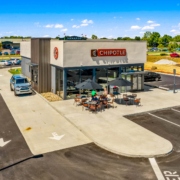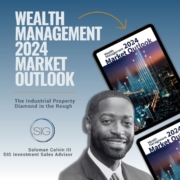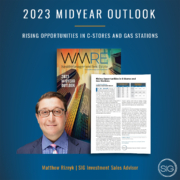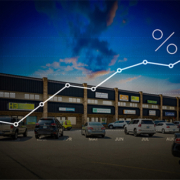Whether you are brand new to CRE or a veteran investor, the time is going to come when you want to start growing your commercial real estate portfolio. Even if you have solid investments in place, it’s wise to look for ways to build your portfolio into one that will help you meet your financial goals.
No two investment portfolios are identical and investors typically choose different CRE asset types to put their money into. Real estate portfolios can include investments in real estate investment trusts (REITs), real estate mutual funds, or investment properties like office, retail, multifamily, or industrial space.

Tips for Growing Your Commercial Real Estate Portfolio
When growing your commercial real estate portfolio, there are several areas you should focus on. From finding the asset types that will serve you best all the way through deal negotiation, the following tips will be helpful as your CRE portfolio develops.
Setting Goals and Making Plans
The first step in building your CRE portfolio is to think about your financial goals. What do you want your investments to achieve? Are you looking for an additional source of monthly income to pay the bills? Do you want to work towards complete financial freedom and build a business based on CRE investments? Do you want to put away more money for your family and retirement? These are all valid goals that a good CRE investment portfolio can help you achieve.
Once you have set your financial goals, you can make a plan to build a portfolio that will serve your needs. Creating a real estate business plan with specific goals laid out will give you a roadmap to follow on your investment journey. The map may change, but having a starting point is essential. Consulting with an investment advisor specializing in commercial real estate is beneficial for making your CRE business plan.
Exploring Different CRE Asset Types
If you’re interested in growing your commercial real estate portfolio, keep an open mind about investing in different types of commercial properties. There are a lot of commercial properties out there, and not all of them will be right for your portfolio, but some will. The best type of property for your portfolio will depend on the market you’re in, how much money you have to invest, your timeline, and many other factors. That’s why we recommend consulting a commercial real estate advisor about different types of properties.
You will want to consider the type of income you want from your property as well as the CRE product type that will provide the best return on investment for you.
Types of Property Investment Income
One factor to take into account when you’re looking to build a strong CRE portfolio is the type of income you want from your property investment. There are two types of investment income: cash flow and capital gains (sometimes called capital growth). To build a strong portfolio, you might want to consider both types of investment income.
Capital Gains Investments
Capital gains investments are made with the goal of capitalizing on the long-term appreciation of a property. In simpler terms, you buy a property with the intention of keeping it for a period of time before selling it for a profit. The popular motto of “buy low and sell high” is the central idea of capital gains investing. ROI is usually higher in capital gains investment than it is in cash flow investment. However, it is riskier because there is more speculation involved and market fluctuations can make a big impact on success.
Capital gains investors are often called “flippers” and fall into two categories:
- Investors who buy a property and flip it as-is: These investors buy on market speculation. They buy properties and don’t make any changes in anticipation that the market down the road will yield a profit when they sell the property.
- Investors who buy, fix, and flip a property: These investors buy properties and invest time, money, and labor into improving the properties with the goal of using the upgrades to increase the value and selling price of the property.
Cash Flow Investments
Cash flow investments are based on the potential return on investment (ROI) the investment will yield on a regular basis. Rental properties in asset classes like office space, multifamily buildings, and self-storage facilities are examples of cash flow investments. Cash flow is your profit after collecting income, paying expenses, and reserving funds for future expenses or repairs.
Cash flow investments are usually long-term compared to capital gains investments. With a cash flow investment, you’re not purchasing the property with the intention of selling within a short span of time. When deciding whether or not a cash flow property is a good addition to your portfolio, keep these factors in mind:
- The rentability of the property and projected occupancy
- The expenses related to maintaining and/or improving the property
- The potential for property value appreciation
CRE Product Types
Commercial properties can also be put into different categories based on the type of business that uses the property, or what the purpose of the property is. These categories include multifamily, office, retail, industrial, hospitality, and special use. Sands Investment Group specializes in the following CRE product types:
Acquiring Assets
With your goals set and a plan in place, you can start building their portfolios by acquiring assets. The acquisition process includes:
- Studying Market Trends
- Evaluating Properties
- Analyzing Potential Income
- Calculating Expenses of Purchase
- Negotiating a Deal
Studying the market and looking at the properties that fit into your investment strategy are the beginning stages of the acquisition process. This groundwork is important for making the right choice, but there’s a lot more work involved. You may have found your dream property to add to your portfolio, but you need to analyze your potential income and calculate the expenses involved in purchasing the property before you can start negotiating a deal.
Getting a commercial property appraisal is an important part of the property evaluation process. No matter what your goals are with the purchase or sale of a property, an appraisal will be necessary. A commercial real estate appraisal helps to determine the value of a property. To learn about this step in the process, read our guide on What You Need to Know About a Commercial Real Estate Appraisal.
And of course, negotiating and closing the deal completes the acquisition process. Partnering with the right broker during your CRE purchase will help you negotiate the best deal possible for all parties involved. After a property is acquired and added to your portfolio, you can start considering your next move.
Balancing and Diversifying the Portfolio
As you are growing your commercial real estate portfolio, it’s important to take steps to balance and diversify the portfolio. As has been stated many times, you cannot avoid risk in the world of commercial real estate investment if you want to reap the rewards of profit. However, there is a line between taking risks and being reckless with your money. Diversifying your investments has the potential to strike a healthy balance between risk and reward.
Even when staying on top of commercial real estate trends, the market can be unpredictable and sometimes volatile. Having a balanced and diversified CRE portfolio can reduce the risk of loss or soften the blow if a certain asset class takes a hit in the market.
What Is Diversification?
When referring to investing as a whole (not just CRE investments), a diversified portfolio would include components like domestic and international stocks, bonds, short-term investments, mutual funds, and real estate investments.
Diversifying Commercial Real Estate Investment
Diversification means investing in different property types with unique risk-reward profiles. Investors can diversify their CRE portfolios in several ways, including:
- Investing in different asset types
- Investing in different asset classes
- Diversifying investments by geographical location or market
- Using multiple investment strategies and hold-times
- Mixing passive and active investments
Exploring different CRE product types is a great way to start the diversification process. You may also want to consider growing your commercial real estate portfolio with alternative investments. To learn more, read our guide to Diversifying Your Portfolio with Alternative Investments.
Choosing the right strategy for growing your commercial real estate portfolio will depend on economic and demographic cycles. An experienced commercial real estate advisor will be able to help you navigate the different types of properties and which would suit your CRE portfolio best.

Get in Touch with a SIG Advisor
If you’re interested in growing your commercial real estate portfolio, get in touch with a SIG advisor. Our experts are uniquely positioned to help you get the most out of your investments. We have brokers that are designated experts in each CRE product type.
Want to learn more? Call 844.4.SIG.NNN or contact us here to consult with a SIG advisor about growing your commercial real estate portfolio.
























